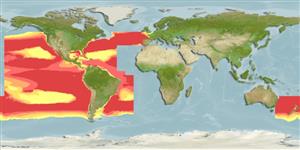>
Stomiiformes (Lightfishes and dragonfishes) >
Stomiidae (Barbeled dragonfishes) > Malacosteinae
Etymology: Aristostomias: Greek, aristos = the best + Greek, stoma = mouth (Ref. 45335).
Eponymy: Otto Hilgard Tittmann (1850–1938) was a geographer, geodesist and astronomer. [...] (Ref. 128868), visit book page.
Environment: milieu / climate zone / depth range / distribution range
पारिस्थितिकी
समुद्री बैथीपिलाजिक; गहराई सीमा 15 - 2000 m (Ref. 58302). Subtropical; 52°N -
Eastern Atlantic: Azores. Western Atlantic: Canada to the Gulf of Mexico and the Caribbean Sea. Southeast Pacific: off Chile.
आकार / वज़न / Age
Maturity: Lm ? range ? - ? cm
Max length : 21.5 cm SL पुल्लिंग / अलिंग; (Ref. 6684)
Short description
पहचान कुंजी | आकृति विज्ञान | मौरफोमैटरिक्स
पृष्ठीय सौफट रेज़ (सम्पूर्ण) : 20 - 23; ऐनल सौफट रेज़: 24 - 29. Body moderately elongate and slender. Chin barbel bearing club-shaped bulb (Ref. 37039).
Meso- and bathypelagic (Ref. 58302).
Life cycle and mating behavior
परिपक्व अवधि | पुनरुत्पत्ति | मछलीऔ का अंडे देना | अंडे | Fecundity | लार्वा
Gibbs, R.H. Jr., 1984. Malacosteidae. p. 366-370. In P.J.P. Whitehead, M.-L. Bauchot, J.-C. Hureau, J. Nielsen and E. Tortonese (eds.) Fishes of the north-eastern Atlantic and the Mediterranean. UNESCO, Paris. Vol. 1. (Ref. 6684)
IUCN Red List Status (Ref. 130435: Version 2024-2)
Threat to humans
Harmless
Human uses
साधन
Special reports
Download XML
इंटरनेट स्रोत
Estimates based on models
Preferred temperature (Ref.
123201): 5 - 15.3, mean 9.4 °C (based on 411 cells).
Phylogenetic diversity index (Ref.
82804): PD
50 = 0.5156 [Uniqueness, from 0.5 = low to 2.0 = high].
Bayesian length-weight: a=0.00407 (0.00157 - 0.01056), b=3.10 (2.88 - 3.32), in cm total length, based on LWR estimates for this (Sub)family-body shape (Ref.
93245).
Trophic level (Ref.
69278): 4.2 ±0.73 se; based on food items.
लौटाव (Ref.
120179): माध्यम, न्यूनतम जनसंख्या दुगनी होने का समय 1.4 - 4.4 वर्ष। (Preliminary K or Fecundity.).
Fishing Vulnerability (Ref.
59153): Low vulnerability (16 of 100).
